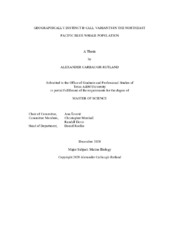| dc.description.abstract | Passive acoustic monitoring is an effective tool for delineating population structure of blue whales (Balaenoptera musculus). Globally, there are at least nine regionally distinct blue whale songs, with two to three distinct groups within the North Pacific Ocean: The Northeast Pacific (NEP), Central-Western Pacific, and putative Japanese populations. Investigation of the fine-scale frequency characteristics of the NEP blue whale song B unit was conducted from passive acoustic data collected between 2010 and 2013. Data were collected at two low latitude, putative breeding sites at Palmyra Atoll and the Hawaiian Islands, and three higher latitude, feeding locations: off Southern California, off Washington state, and in the Gulf of Alaska. Frequency measurements were extracted along the entire contour of the third harmonic of B calls using a custom feature extraction tool in MATLAB. Data from these different geographic regions were compared to investigate possible fine-scale song separation within the NEP, and regionally distinct differences were observed. Calls recorded in the Gulf of Alaska presented a noticeable downshift in frequency that begins just past the midway point of the contour. This downshift was absent in calls recorded from Southern California, and calls recorded in Washington displayed intermediate characteristics of these two sites. Furthermore, frequency differences were observed between the three feeding grounds, with calls recorded from the Gulf of Alaska displaying the highest frequency on average, followed by Washington, followed by Southern California. Contours from Palmyra Atoll showed striking resemblances to those in Southern California, and contours from Hawaii showed similarities to those of the Gulf of Alaska. Cluster Analysis further supported these results, by indicating that there are at least two unique B call groupings across these five sites, and contours from Washington and Hawaii were consistently grouped together while contours from Hawaii and Gulf of Alaska were consistently grouped together. These results provide the first evidence of vocally distinct subpopulations within the NEP, or that these animals are demonstrating vocal plasticity in a regionally-specific manner. | en |


